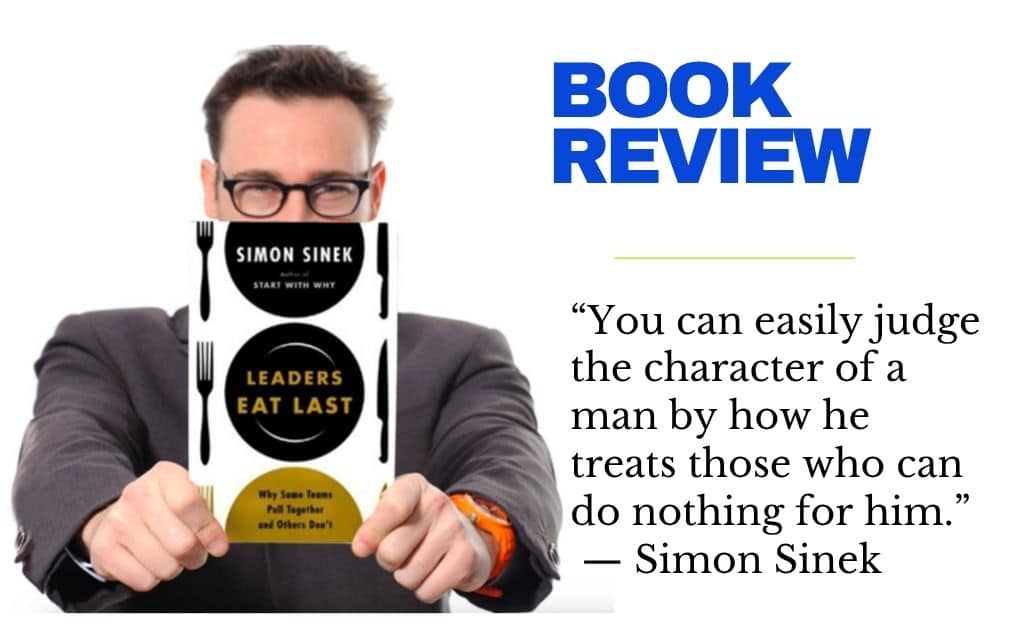Why do some teams pull together while others fall apart under pressure?
That’s the central question Simon Sinek tackles in his powerful book, Leaders Eat Last: Why Some Teams Pull Together and Others Don’t. Drawing from biology, history, and business, Sinek reveals why trust, empathy, and safety are essential to great leadership—and how the best leaders make their teams feel protected and valued.
Whether you’re a manager, executive, entrepreneur, or aspiring leader, this summary will help you understand the principles that make leadership truly transformative.
What Is "Leaders Eat Last" About?
In "Leaders Eat Last," Simon Sinek explores the biological drivers behind human behavior in teams and explains how modern workplaces can either enhance or destroy trust and cooperation.
The title comes from a lesson Sinek learned from the U.S. Marine Corps: leaders eat last—literally. Officers let their troops eat first as a sign of selflessness and responsibility. That simple action represents a larger idea: great leaders prioritize the well-being of their people.
Key Themes:
- The importance of psychological safety
- Leadership driven by empathy and trust
- The biological chemicals behind behavior (endorphins, dopamine, serotonin, oxytocin, cortisol)
- Why toxic workplaces form—and how to fix them
For more on workplace trust and emotional safety, read this Harvard Business Review article on psychological safety.
Core Lessons from Leaders Eat Last
1. The Circle of Safety
Sinek argues that organizations thrive when leaders create a “Circle of Safety” — an environment where employees feel protected from internal politics and fear.
- What it means: Team members feel secure to take risks, speak up, and collaborate.
- Why it matters: When people feel safe, they focus on shared goals instead of protecting themselves.
“The strength of the culture, not the size of the company, determines an organization’s ability to adapt and thrive.”
Read about how Google developed its own high-performing teams through Project Aristotle—and how psychological safety ranked #1.
2. The Biology of Leadership
Sinek ties leadership to four key chemicals that influence our decisions and emotions:
- Endorphins: Help us power through challenges (like exercise or hard work)
- Dopamine: Drives goal-setting and achievement
- Serotonin: Boosted when we feel respected or acknowledged
- Oxytocin: Released through trust and bonding
- Cortisol (the bad one): Released during stress and fear
If you're curious about how these chemicals affect workplace behavior, explore this neuroscience-based guide to leadership.
3. Empathy Over Numbers
In an age where data and profits dominate decision-making, Sinek reminds us that people matter more than metrics.
- Great leaders listen to their team.
- They support emotional well-being.
- They sacrifice short-term gains to build long-term trust.
Gallup's State of the Global Workplace Report reveals that only 20% of employees feel engaged at work—highlighting the need for empathetic leadership.
4. Leadership Is a Responsibility, Not a Rank
Sinek challenges the idea that leadership comes with a title. True leadership is about serving others, not commanding them.
“Leadership is not about being in charge. It’s about taking care of those in your charge.”
This aligns with the servant leadership model introduced by Robert Greenleaf. You can read more about it here.
Practical Takeaways for Leaders
Here are actionable ideas you can implement from Leaders Eat Last:
- Put people before profits: Profits follow when people feel safe and motivated.
- Recognize effort, not just outcomes: Praise builds serotonin and loyalty.
- Lead by example: Don’t just delegate; demonstrate values through action.
- Create safe spaces: Encourage open feedback and discussion without fear of punishment.
- Support work-life balance: Burnout destroys performance and trust.
For insights on how to build a strong company culture, check out CultureAmp’s guide on building trust at work.
Real-World Applications
Sinek shares stories from:
- The military: Marines teach selfless leadership from day one.
- Business: Companies like Barry-Wehmiller thrive by valuing people over process.
- Government: Dysfunction arises when leaders protect themselves instead of their people.
Read how Barry-Wehmiller became a case study in human-centered leadership from Simon Sinek’s official blog.
Why “Leaders Eat Last” Matters Today
In a post-pandemic world of remote teams, mental health struggles, and quiet quitting, the insights in this book are more relevant than ever.
People don’t leave jobs—they leave toxic leaders. Leaders Eat Last makes a compelling case for human-centered leadership as the future of sustainable success.
For trends in leadership and culture in 2025, explore McKinsey’s latest organizational report.
Top Quotes from Leaders Eat Last
“You can easily judge the character of a man by how he treats those who can do nothing for him.”
— Simon Sinek
“The cost of leadership is self-interest.”
“A boss has the title, a leader has the people.”
FAQ
Q: Who should read Leaders Eat Last?
A: Anyone in a leadership role—from CEOs to team leads—or anyone aspiring to lead others with empathy and integrity.
Q: Is this book only for business leaders?
A: No, the lessons apply to military, nonprofits, schools, and even families—anywhere leadership matters.
Q: What’s the main takeaway of the book?
A: Great leaders sacrifice for their team, creating environments of trust, empathy, and safety.
Q: How is this different from Simon Sinek’s other books like Start With Why?
A: Start With Why focuses on purpose and vision; Leaders Eat Last focuses on how leaders build cultures that support that vision.
Q: Does the book offer practical steps?
A: Yes, it includes both science-based

